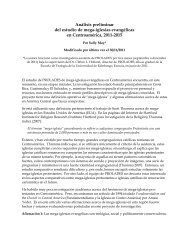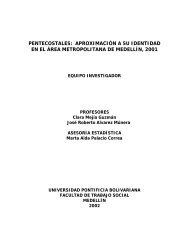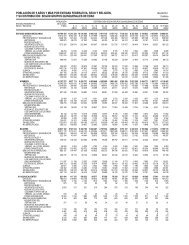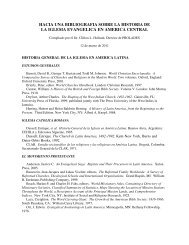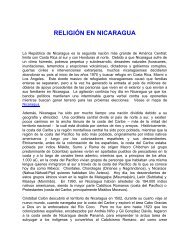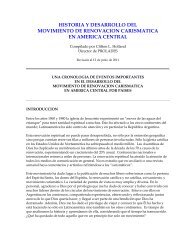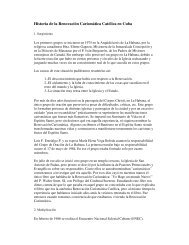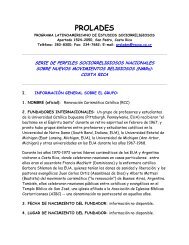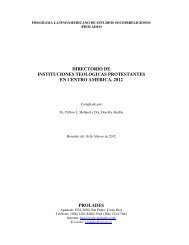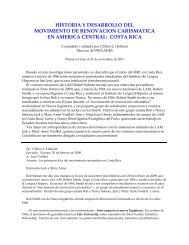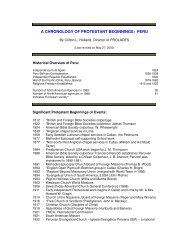belize, 1980 - Prolades.com
belize, 1980 - Prolades.com
belize, 1980 - Prolades.com
Create successful ePaper yourself
Turn your PDF publications into a flip-book with our unique Google optimized e-Paper software.
on the sample of 253 Protestant congregations that were geographically located by District and<br />
Region in Part II of the Directory of Churches, Organizations and Ministries of the Protestant<br />
Movement in Belize. However, we were unable to locate geographically five congregations that<br />
were reported to exist by the various denominations in Part I of the Directory, for a total of 258.<br />
(2) A similar <strong>com</strong>parison can be made at the District level within each Region and for all<br />
Districts of the country irrespective of Region. The greatest difference between the congregation-topopulation<br />
ratios for all Districts is shown by Corozal District, which had 15.5% of the national<br />
population but only 9.1% of all Protestant congregations. In the Southern Lowlands, the two<br />
Districts (Stan Creek and Toledo) had a higher percentage of congregations than of the total<br />
population, which is reflected in the low congregation-to-population ratios; the same was true for the<br />
Mayan Highlands (Cayo District).<br />
(3) Although all Districts in Belize had a relate low congregation-to-population ratio <strong>com</strong>pared<br />
to other Central American countries where special efforts are being made to plant more new<br />
congregations in each geographical area (district, municipality and department or province) where<br />
the congregation-to-population ratio is greater than 1:1,000. In the case of Belize, the Northern<br />
Lowlands had the highest such ratio for the country, with 1:702, which is a reflection of the strong<br />
evangelical presence in Belize. However, in the Northern Lowland Region, the District of Corozal<br />
had the highest congregation-to-population ratio in the country, with 1:966. What this means is that,<br />
in <strong>com</strong>parison to all the Districts of Belize, the District of Corozal should be a priority area for new<br />
church planting among evangelical denominations, because this is where the greatest need exists<br />
for evangelization and church planting efforts. Orange Walk District (1:669) should be the next<br />
priority, followed by Belize District that has the nation’s largest concentration of population, with<br />
49,831, and a congregation-to-population ratio of 1:639.<br />
In Figure 17, we can <strong>com</strong>pare the geographical distribution of Protestant congregations<br />
(churches and missions) by Region and District and by Major Traditions of the Protestant Movement<br />
for <strong>1980</strong>.<br />
(1) The Liturgical Tradition, represented in Belize by the Anglican Church and two<br />
Presbyterian denominations (St. Andrew’s Presbyterian Church and the National Presbyterian<br />
Church of Mexico) is highly concentrated in the Northern Lowlands Region (57.6%) and particularly<br />
within Belize District (34.5%), followed by the Southern Lowlands Region (30.3%) and particularly<br />
within Stan Creek District (24.2%).<br />
(2) The Separatist Tradition (also called Free Church Tradition) also was heavily concentrated<br />
in the Northern Lowlands Region (56.4%), especially in Belize District (34.5%) and Orange<br />
Walk District (17.3%). In addition, the Separatist Tradition had a strong presence in the Southern<br />
Lowlands Region (26.4%): Stan Creek District (11.8%) and Toledo District (14.5%).<br />
(3) The Adventist Tradition had the highest concentration in the Northern Lowlands Region<br />
(67.5%) <strong>com</strong>pared to all other traditions. The Adventist presence was especially strong in Belize<br />
District (32.5%) and Corozal District (25.0%), followed by Cayo District (17.5%) in the Mayan Highlands<br />
Region and by Stan Creek District (12.5%) in the Southern Lowlands Region.<br />
(4) The Pentecostal Tradition is less represented in Belize than in other Central American<br />
countries. Its strongest presence is in Toledo District (25.0%) of the Southern Lowlands Region and<br />
in Cayo District (25.0%) of the Mayan Highlands Region, followed by Belize District (23.4%) in the<br />
Northern Lowlands Region. However, in terms of regions, the Northern Lowlands had the highest<br />
concentration of Pentecostal churches with 26 (40.6%). Overall, the Pentecostal churches were the<br />
most evenly distributed throughout the country.<br />
(5) There were three denominations (or independent churches) with a total of six<br />
congregations that we were unable to classify for lack of information: one in Belize District, one in<br />
Toledo District and four in Cayo District.<br />
31



